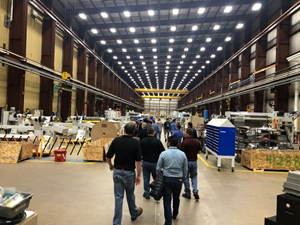AICC Members Learn Corrugator Best Practices
- Published: November 11, 2019
 To a sold-out group of 30 packaging professionals AICC, The Independent Packaging Association, taught Best Practices for Corrugator & Maintenance Operations, October 9-10, in De Pere and Phillips, WI at Green Bay Packaging and BW Papersystems Corrugator Headquarters and Four Seasons Learning and Manufacturing Facility.
To a sold-out group of 30 packaging professionals AICC, The Independent Packaging Association, taught Best Practices for Corrugator & Maintenance Operations, October 9-10, in De Pere and Phillips, WI at Green Bay Packaging and BW Papersystems Corrugator Headquarters and Four Seasons Learning and Manufacturing Facility.
“It is a course I needed. I have done corrugator training, but this involves everybody doing simple things and how to change their habits,” said Chad Rowsell, corrugator department leads, Kruger Packaging.
The first day of the experience was held at Green Bay Packaging. Zach Vandenheuvel welcomed the group. Scott Ellis, principle, Working Well, interviewed participants as to what they came to learn. He also challenged them to return home with an implementation plan. Steve Nerney installation training leader at BW Papersystems, began a discussion on singlefacers. After a review of the technology, he discussed a maintenance checklist and the four items that make the bond- PEST: pressure, energy, starch and time. Nerney covered the solutions to common singlefacer issues, like Roll Unit Lubrication Schedule, correcting scraper settings, and maintaining proper chamber pressure. He also gave tips to correct issues with the pressure chamber seals.
Next, Jon Klass and Mat Parkin, both territory managers at Lube Tech, shared Fundamentals of Lubrication with attendees. They began by explaining the uses of lubrication, which include preventing wear, reducing friction, removing heat and preventing corrosion. Then, they reviewed lubricant composition, the refinement process and additives. Klass and Parkin also compared oil to grease, allowing attendees to understand which to use in various situations.
One hot topic of the day was steam, presented by Rick Duke, senior process specialist-corrugated, Kadant Johnson Systems. He covered the importance of the boiler firing rate, safety relief valves and the careful balance that must be found when using chemical additives. His presentation included the specific conductivity and pH levels needed for success. He also offered a simple solution to the troubleshoot steam systems- gauge accuracy. Duke also discussed testing and offered a list of top ten best practices, which included starting a boiler slowly, blowing out all strainers at least monthly, and checking traps monthly.
After lunch, attendees were invited to tour the Green Bay Packaging facility, where they saw how to use process tools and conduct testing. The afternoon training began with corrugator belt care, presented by Michael Harris, president, KPI Incorporated. Harris began by helping attendees determine the best corrugator belt for their home plants by covering the different types, woven, needled felt and lightweight, then he moved the discussion into solving starch build-up issues, before reviewing belt caliper and measuring tools. He also offered tips to protect the belt when shutting down the corrugator, which included insulating the belt from prolonged heat and leaving paper under hotplates. Harris finished his presentation with key performance indicators.
The participants then bussed to BW Papersystems Corrugator Headquarters and Four Seasons Learning and Manufacturing Facility, where they enjoyed networking over dinner at the Lakeside Lodge.
The following morning began with tips and tactics for knife cut length accuracy by Brett Bergstrom, training specialist, BW Papersystems. He focused on locating knife wear parts, predicting and scheduling maintenance and changing parts prior to failure. Bergstrom helped members learn tips to minimize board crush before offering more than a dozen operator maintenance items that will increase production. He also shared visual cues for the roll and cut quality that highlighted when action is needed.
Then, Steve Nerney, installation training leader, BW Papersystems, taught about the splicer process. He began with a review of the four M’s of the splicing process- Materials, Machines, Manpower, and Methods. He then offered detailed information about each phase, including operator best practices, which included ensuring proper roll preparation, consistent splicing preparation, machine clean-up, and “process ownership.” Nerney completed his presentation by sharing a splicing process checklist.
Bergstrom returned to explain how to maintain a sharp slit edge, head setup accuracy, and improve board quality during his presentation, Slitter Scorer: Staying Sharp. He compared carbide and steel blades. Then Bergstrom gave attendees more than a dozen easy checks to perform on the sharpening system and anvils to optimize performance. He also discussed preventative maintenance and the role of operators and maintenance personnel. Attendees were able to see examples of worn-down parts to allow attendees to see what to look for. He completed his presentation by walking through the why and how of slitter calibration.
He then began the final technical presentation of the seminar, which focused on the stacker. Bergstrom discussed the many attributes of production, like dry end speeds, knife, flat belts, and the lift bay, that affect stack quality. Bergstrom shared various pictures of rolls, outfeeds, and shingling belts and asked attendees to identify the problems they saw that would impact stacker quality.
Attendees then toured BW Papersystems, where even seasoned corrugator professionals were able to see components of the process as they were prepared for the field which offered an instructive view of the machine's inner workings. Finally, on the bus ride back to Green Bay, Ellis helped individuals plan their implementation of best practices in their home plants.
AICC thanks Green Bay Packaging and BW Papersystems for their contributions to the success of this seminar.
For more information, visit www.aiccbox.org.




